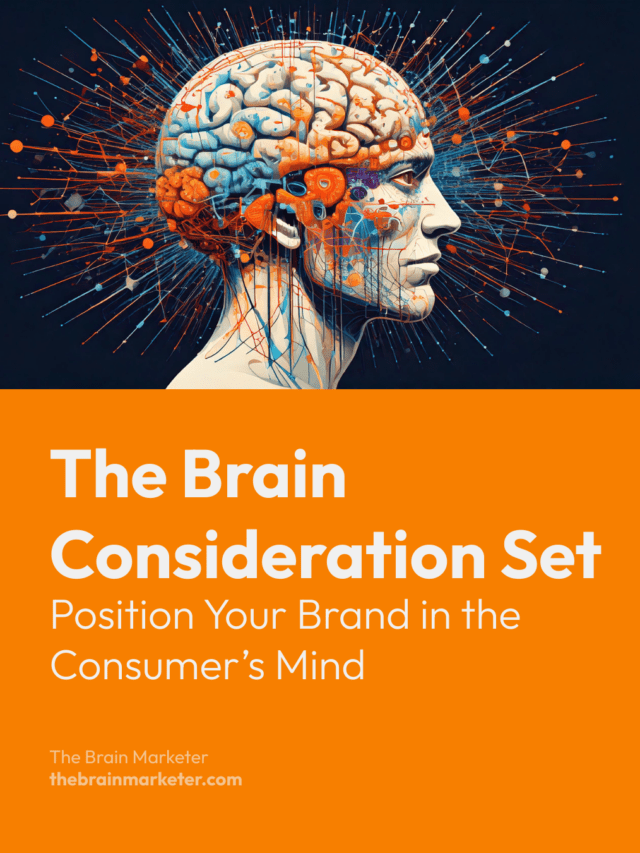The “brain consideration set” is a strategic lever in brand positioning. It refers to the limited number of brands a consumer spontaneously recalls when thinking of a product category. Being part of this mental shortlist is critical. It determines whether consumers even consider your brand at the moment of purchase. This article explores how to secure that mental spot—using neuromarketing, emotional triggers, and visual memory.
Key Takeaways
- A consideration set is the mental shortlist of brands recalled during decision-making.
- Strong mental associations, built through stimuli and repetition, drive inclusion.
- The primal brain responds to emotion, contrast, and symbols—all crucial to positioning.
- Strategic consistency across touchpoints reinforces memory and recall.
- Comparative advertising can anchor a brand in the consumer’s mind via contrast.
🎙️ Unpack the Topic with this Podcast
What Is a Consideration Set?
A consideration set is the group of brands that come to mind when consumers think of a product or service category.
Example: Think “fast food,” and you may immediately recall McDonald’s, Burger King, or Subway. These brands have shaped your brain’s consideration set through consistent branding and repeated exposure.
In Switzerland, say “orange juice,” and many people will say “Granini”. That’s not chance, it reflects years of strategic brand work.

How to Position Your Brand in the Brain Consideration Set
To earn a place in the consumer’s mental shortlist, your brand must create strong, emotionally charged associations. This requires deliberate and consistent marketing efforts. The following steps show how to use neuromarketing principles to achieve this goal.
Step 1: Align Your Brand Personality with Category Expectations
Your brand’s personality guides how it fits within a consideration set. Is it sincere, exciting, or competent? Make this positioning clear and relevant to your audience.
Example: A wellness brand targeting the “healthy snacks” category should convey vitality and trust through visuals, messaging, and storytelling.
Use brand storytelling to shape emotional perception and reinforce your brand archetype.
Step 2: Use Stimuli to Anchor Brand Associations
Consumers face a constant flood of marketing inputs. To stand out, use consistent and repetitive stimuli—colors, sounds, logos, and packaging—that embed your brand in memory.
Example: McDonald’s golden arches, Nike’s swoosh, and Apple’s minimalist packaging all serve as powerful mnemonic devices.
Audit your brand touchpoints. Are your visual and auditory cues consistent, memorable, and repeated across platforms?
Step 3: Build Mental Maps Through Emotional Associations
Emotion, more than logic, drives memory. Strong brands tie their identity to emotional contexts: joy, relief, freedom, or status.
Example: Coca-Cola owns the feeling of celebration. When joy links to a beverage, Coke often comes to mind.
Neuromarketing Insight: The primal brain remembers what is emotionally intense and visually simple. Leverage that dynamic.
Engaging the Primal Brain: Two Proven Techniques
1. Before-and-After Scenarios
Demonstrate transformation. Make the contrast clear and immediate.
Example: A cleaning product ad showing a greasy surface followed by a sparkling clean result helps the brain process effectiveness instantly.
2. Visual Triggers and Archetypes
Symbols activate emotion and create cognitive shortcuts. Think shield (protection), wings (freedom), or flame (desire).
Example: Nike’s swoosh conveys motion and personal victory creating a lasting mental imprint.
Case Study: Competitive Contrast Anchors Memory
Comparative advertising does more than entertain, it strengthens positioning through contrast.
Example from the Automotive Sector:
- BMW: “Congrats Audi, from the World Car of the Year.”
- Audi: “Thanks BMW, from the Le Mans Champion.”
- Subaru: “Great job on the beauty contest. From the Engine of the Year winner.”
This playful exchange helped all three brands stay top-of-mind each associated with a distinct competitive strength.
Conclusion
YYour brand exists in the consumer’s mind long before it ends up in their shopping cart. To earn and keep that spot:
- Define your positioning through a clear brand personality.
- Repeatedly expose consumers to consistent, memorable stimuli.
- Use emotional anchors and visual simplicity to strengthen recall.
The brain rewards clarity, repetition, and emotion. Use them to ensure your brand is the one consumers remember and choose.
Sources
- Romaniuk, Jenni. Building Distinctive Brand Assets. Oxford University Press.
- Heath, Chip & Heath, Dan. Made to Stick. Random House.
- Kahneman, Daniel. Thinking, Fast and Slow. Farrar, Straus and Giroux.
- Renvoisé, Patrick & Morin, Christophe. The Persuasion Code. Wiley.
- Ehrenberg-Bass Institute. How Brands Grow series.

Vincent Heimann is a marketing project manager and neuromarketing enthusiast. He founded The Brain Marketer to bridge neuroscience and marketing through accessible, science-based content. With over 10 years of experience in digital strategy, UX/UI and communication, he shares practical insights to help brands connect with the human brain — ethically and effectively

